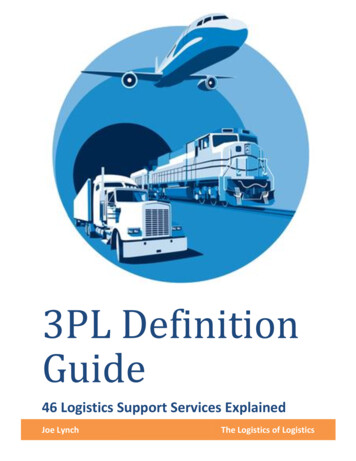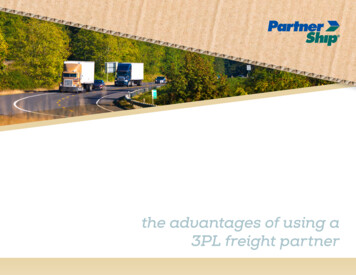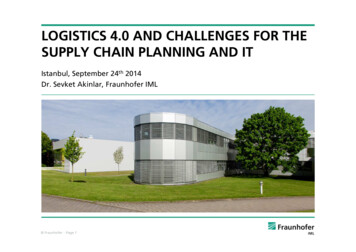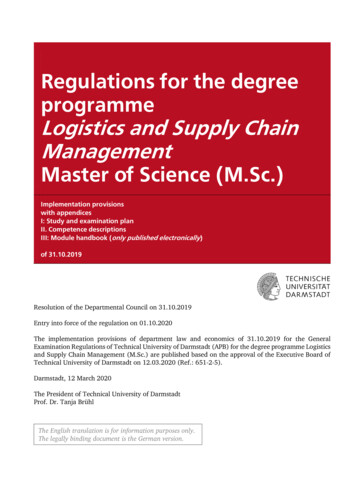
Transcription
3PL DefinitionGuide46 Logistics Support Services ExplainedJoe LynchThe Logistics of Logistics
3PL Definition Guide - 46 Logistics Support Services ExplainedAbout This Ebook . 4Chapter 1:. 53PL Defined . 53PL Definitions . 61PL (1st Party Logistics). 62PL (2nd Party Logistics) . 63PL (3rd Party Logistics) . 74PL (4th Party Logistics) . 7Overlapping . 7Asset Based 3PLs . 8Management Based 3PLs . 8Integrated 3PLs . 8Chapter 2:. 9Logistics Services . 10Logistics Services – Inbound Logistics . 10Logistics Services – Just-in-Time (JIT) . 10Logistics Services - Payment Auditing / Processing . 10Chapter 3:. 12Transportation Services . 13Transportation – Package Delivery . 13Transportation – Air Cargo. 13Transportation - Ocean . 13Transportation - Less Than Truckload (LTL) . 14Transportation - Truckload . 14Transportation – Fleet Acquisition. 14Transportation – Equipment / Drivers . 15Transportation - Dedicated Contract Carriage. 15Transportation - Intermodal . 15Transportation – Final Mile . 16Transportation - Rail . 16Chapter 4:. 17 Copyright protected, 2013-1-TheLogisticsofLogistics.com
3PL Definition Guide - 46 Logistics Support Services ExplainedWarehousing . 18Warehousing – Pick and Pack . 18Warehousing – Sub-assembly . 18Warehousing – Site Location . 18Warehousing – Transloading . 19Warehousing - Distribution Center Management . 19Warehousing - Vendor Managed Inventory . 19Warehousing – Cross-docking. 20Warehousing - Fulfillment . 20Chapter 5:. 21Special Services . 22Special Services - Direct to Home . 22Special Services - Direct to Store . 22Special Services - Sustainability and Green Logistics . 22Special Services - Reverse Logistics. 23Special Services - Product Lifecycle Management . 23Special Services - Supply Chain Security Analysis . 23Special Services - Contingency / Crisis Planning . 23Special Services – Global Expansion . 24Special Services – Foreign Trade Zone . 24Special Services – Logistics/Transportation Consulting . 24Special Services - Import / Export / Customs . 25Special Services – Labor Management . 25Special Services – Marketing / Customer Service . 26Chapter 6:. 27Technology/Web Services. 28Technology / Web Services - EDI . 28Technology / Web Services - Enterprise Resource Planning (ERP) . 28Technology / Web Services - Predictive Analytics . 28Technology/Web Services – Global Trade Management (GTM) . 29Technology / Web Services - Transportation Management System (TMS) . 29 Copyright protected, 2013-2-TheLogisticsofLogistics.com
3PL Definition Guide - 46 Logistics Support Services ExplainedTechnology / Web Services - Warehouse Management System (WMS) . 29Technology/Web Services – Supplier Management . 30Technology/Web Services – Customer Management . 30Technology / Web Services - Cloud Based Solutions . 30Technology / Web Services - Visibility . 31Technology / Web Services - Wireless . 31 Copyright protected, 2013-3-TheLogisticsofLogistics.com
3PL Definition Guide - 46 Logistics Support Services ExplainedAbout This Ebook3PLs help companies with a wide variety of logistics tasks – which is why it can be difficult to understandwhat defines a 3PL and how they work. And that doesn’t even scratch the surface on understandingwhat the various types of 3PLs and logistics support services do.That’s why in this ebook, we’ll start by defining what a 3PL actually is – along with 1PLs, 2PLs, and 4PLsand an explanation of different 3PL business models. Then we’ll give you the crash course on 46different logistics services.We’ve split up the services into five sections: Logistics Services, Transportation Services, WarehousingServices, Special Services, and Technology/Web Services. Copyright protected, 2013-4-TheLogisticsofLogistics.com
3PL Definition Guide - 46 Logistics Support Services ExplainedChapter 1:3PL Defined Copyright protected, 2013-5-TheLogisticsofLogistics.com
3PL Definition Guide - 46 Logistics Support Services Explained3PL Defined3PL DefinitionsSince there is not one perfect definition of a 3PL, here are a few definitions from three different logisticsauthorities.According to CSCMP, a Third Party Logistics Provider is:A firm which provides multiple logistics services for use by customers. Preferably, these services areintegrated, or "bundled" together by the provider. These firms facilitate the movement of parts andmaterials from suppliers to manufacturers, and finished products from manufacturers to distributors andretailers. Among the services which they provide are transportation, warehousing, cross-docking,inventory management, packaging, and freight forwarding.According to the Consumer Product Safety Improvement Act of 2008, the legal definition of a 3PL is:A person who solely receives, holds, or otherwise transports a consumer product in the ordinary course ofbusiness but who does not take title to the product.According to Logistics Focus, Third Party Logistics is:The activity of outsourcing activities related to Logistics and Distribution. The 3PL industry includesLogistics Solution Providers (LSPs) and the shippers whose business processes they support.So if that explains a 3PL, then what is a 1PL, 2PL, or 4PL?1PL (1st Party Logistics)1PL consists of the very basics of shipping and receiving – the shipper, and the consignee. In the earlydays of logistics the only parties involved were these “1PLs”.2PL (2nd Party Logistics)2PL consists of carriers, such as trucking companies, airlines, shipping companies, and rail companies. Asearly supply chains developed, carriers were the 2nd party to get involved. Copyright protected, 2013-6-TheLogisticsofLogistics.com
3PL Definition Guide - 46 Logistics Support Services Explained3PL (3rd Party Logistics)It then followed that 3PL would be the name given to the third parties who add additional services tothe supply chain without taking title to the products. 3PLs make money by buying and bundling servicesand adding a markup; for this reason, they have carrier preferences and relationships.4PL (4th Party Logistics)4PL is the newest level in the hierarchy. A 4PL manages the entire supply chain. They will essentiallymanage the activities of the 3PLs. Unlike 3PLs, 4PLs are carrier neutral, not taking preference for onecarrier or another. They are paid as consultants, by the hour or by the project. The term 4PL was firstcreated by Accenture as a way of describing their services.OverlappingIt can also be possible for a company to be part of more than one “PL” category at once. It is particularlycommon for a 3PL to also be a 2PL. This may occur when: A shipping line owns a freight forwarderAn airline owns a general sales agent (GSA)A freight forwarder owns trucks or a warehouseA courier company owns planesFor example, Fedex is both a 2PL (airline) and a 3PL (courier). DHL is both a 3PL (courier and freightforwarder), a 2PL (warehouse and trucks owner), and a 4PL (actual consulting divisions).Lead Logistics Provider, or LLP, can sometimes be seen as a combination of a 3PL and 4PL. The LLP isgiven the responsibility to manage and carry out the client’s logistics tasks. Part of these activities will beexecuted by the LLP itself. Meanwhile, any additional activities that the LLP doesn’t have expertise in willbe outsourced to 3PLs. These 3PLs are then managed by the LLP. (Practically speaking, the terms LLP and4PL are often used interchangeably, while they may also be viewed as falling under the 3PL category.There is a wide range of definitions for LLPs.)With the confusing and sometimes conflicting labels for 3PLs, perhaps a better way to view the industryis by business model. The three main business models used by 3PLs: asset based, management basedand integrated. Copyright protected, 2013-7-TheLogisticsofLogistics.com
3PL Definition Guide - 46 Logistics Support Services ExplainedAsset Based 3PLsAsset based third party logistics companies use their own trucks, warehouses and personnel to operatetheir business.Management Based 3PLsManagement based 3PLs (sometimes called non-asset based) provide the technological and managerialfunctions to operate the logistics functions of their clients, but do so using the assets of other companiesand do not necessarily own any assets.Integrated 3PLsIntegrated 3PLs can either be asset based or management based companies that supplement theirservices with whatever services are needed by their clients.Now that we’ve cleared up the definition of a 3PL, the types of 3PLs and the rest of the PL hierarchy,here are explanations of 46 of the 3PL services on the market today. Copyright protected, 2013-8-TheLogisticsofLogistics.com
3PL Definition Guide - 46 Logistics Support Services ExplainedChapter 2:LogisticsServices Copyright protected, 2013-9-TheLogisticsofLogistics.com
3PL Definition Guide - 46 Logistics Support Services ExplainedLogistics ServicesLogistics Services – Inbound LogisticsInbound Logistics – The movement of materials from suppliers and vendors into production processesor storage facilities.Logistics Services – Just-in-Time (JIT)Just-in-time (JIT) manufacturing is a production model in which items are created to meet demand, notcreated in surplus or in advance of need.The purpose of JIT production is to avoid the waste associated with overproduction, waiting and excessinventory, three of the seven waste categories defined in the Toyota Production System (known in NorthAmerica as the lean production model).Just in Time (JIT) is a production strategy that strives to improve a business return on investment byreducing in-process inventory and associated carrying costs. To meet JIT objectives, the process relies onsignals or Kanban between different points, which are involved in the process, which tell productionwhen to make the next part. Kanban are usually 'tickets' but can be simple visual signals, such as thepresence or absence of a part on a shelf. Implemented correctly, JIT focuses on continuousimprovement and can improve a manufacturing organization's return on investment, quality, andefficiency. To achieve continuous improvement key areas of focus could be flow, employee involvementand quality.Logistics Services - Payment Auditing / ProcessingA Freight Audit is the process of analyzing and examining the accuracy of freight bills. An auditor willcheck the validity of the charges, ensure that duplicate payments are avoided, and check the accuracy ofthe charges.Freight Payment Outsourcing is a way to reduce a company’s administrative costs to process billpayments. A freight payment/auditing company can save clients 90 – 95% in administrative costs.Both of these services also provide companies with data that they can use to guide their businessdecisions. For example, they can tell companies whether their carrier is charging them above or belowthe going rate, which customers can then use to help them negotiate. Some services can even trackwhether or not vendors followed the customer’s routing guides properly. They then deduct a penaltyfrom the bill if vendors did not follow the instructions. Copyright protected, 2013- 10 -TheLogisticsofLogistics.com
3PL Definition Guide - 46 Logistics Support Services ExplainedThese third party companies can also benefit carriers with the ability to pay them in a matter of days,rather than weeks.Logistics Services – Logistics Process Re-engineeringLogistics process re-engineering is the process of completely reworking an organization’s logisticsprocedures, from purchase to customer delivery. This may be done in the spirit of continualimprovement to remain competitive, or it may be done when the organization is faced with a morepressing problem caused by ineffective processes. A change in the market or customer needs may alsocreate a need for logistics process re-engineering.A 3PL helping a company with logistics process re-engineering will start with an assessment of thebusiness’ current processes, as well as talking to stakeholders to better understand what they want toachieve by overhauling their processes. From there they will redesign the logistics process to meet theneeds of the company. Copyright protected, 2013- 11 -TheLogisticsofLogistics.com
3PL Definition Guide - 46 Logistics Support Services ExplainedChapter 3:TransportationServices Copyright protected, 2013- 12 -TheLogisticsofLogistics.com
3PL Definition Guide - 46 Logistics Support Services ExplainedTransportation ServicesTransportation – Package DeliveryPackage delivery or parcel delivery is the shipping of packages (parcels) or high value mail as singleshipments. While the service is provided by most postal systems, private package delivery services havealso existed in competition with and in place of public postal services.Transportation – Air CargoAir transportation is used to transport air cargo by plane. Air cargo or air transport is a vital componentof many international logistics networks, and it is a vital part of international commerce. Air transportinvolves integration of information, transportation, inventory, warehousing, material handling, andpackaging. Transporting goods to and from the airport is also an essential part of the process.Transportation - OceanOcean transport is used to move goods across the ocean or larger lakes. There are many different typesof cargo that are moved in various types of ships. The ship types include: bulk carriers, container ships,tankers, refrigerated ships, roll on / roll off ships, and multi-purpose ships.Bulk carriers are cargo ships used to move bulk cargo like coal, ore, grains and liquids. Bulk cargo iscommodity cargo that is transported unpackaged in large quantities. It refers to material in either liquidor granular, particulate form, as a mass of relatively small solids, such as petroleum, grain, coal, or gravel.This cargo is usually dropped or poured, with a spout or shovel bucket, into a bulk carrier ship’s hold,railroad car, or tanker truck/trailer/semi-trailer body.Container ships are cargo ships that carry their entire load in truck-size containers, in a technique calledcontainerization. They form a common means of commercial intermodal freight transport. Informallyknown as “box boats,” they carry the majority of the world’s dry cargo.Tankers are cargo ships for the transport of fluids, such as crude oil, petroleum products, liquefiedpetroleum gas, liquefied natural gas and chemicals. They also carry vegetable oils, wine and other food.Refrigerated ships (reefers) are cargo ships used to transport temperature-controlled cargo, such asfruits, meat, fish, vegetables, dairy products and other foodstuffs.Roll-on/roll-off ships are cargo ships designed to carry wheeled cargo such as automobiles, trailers orrailway carriages. RORO (or ro/ro) vessels have built-in ramps which allow the cargo to be efficiently“rolled on” and “rolled off” the vessel when in port. Copyright protected, 2013- 13 -TheLogisticsofLogistics.com
3PL Definition Guide - 46 Logistics Support Services ExplainedA multi-purpose ship (sometimes called a general cargo ship) is used to transport a variety of goodsfrom bulk commodities to break bulk and heavy cargoes. To provide maximum trading flexibility theyare usually geared and modern examples are fitted for the carriage of containers and grains.Break bulk cargo or general cargo is a term that covers a great variety of goods that must be loadedindividually, and not in intermodal containers nor in bulk as with oil or grain. Break bulk cargo istransported in bags, boxes, crates, drums, or barrels. Unit loads of items secured to a pallet or skid arealso used.Transportation - Less Than Truckload (LTL)Less Than Truckload (LTL) is a shipment that does not require a full 48 or 53 foot trailer. There are manycarriers that specialize or offer this service. Like full truck load carriers, the LTL carriers themselvesspecialize in different services such as lift gate and residential pick-ups and deliveries, guaranteedservices, protect from freeze, transit, and bottom line cost to name a few.Within a local area the LTL freight operator has a number of vehicles which collect shipments from theircustomers. After finishing the daily collection, the shipments are taken to a terminal where the vehiclesare unloaded. Each shipment is weighed and rated which allows customer bills to be processed. Theindividual shipment is loaded onto an outbound vehicle which contains shipments from other customersbound for the same geographic area. The outbound shipments are trucked to appropriate regionalterminals, where they are unloaded. The shipments are sorted and placed on local vehicles for delivery.Each individual shipment is handled a number of times from the time it is picked up from the customeruntil it reaches its final delivery location.Transportation - TruckloadTruckload shipping is the movement of large amounts of similar freight, usually the amount necessary tofill an entire semi-trailer or intermodal container. A truckload carrier is a trucking company thatgenerally contracts an entire trailer-load to a single customer.Full truckload carriers normally pick up and deliver dedicated shipments. Typically, shipments arepicked up at the shipper and delivered directly to the consignee. Truckload shipments are generallyhandled less, cost less per unit shipped and have less freight damage.Transportation – Fleet AcquisitionFleet acquisition services help companies acquire trucks. Fleet acquisition companies conduct ananalysis of the client’s needs so they can acquire the right truck(s) for their clients. Copyright protected, 2013- 14 -TheLogisticsofLogistics.com
3PL Definition Guide - 46 Logistics Support Services ExplainedTo specify the truck fleet, the following information is considered: customization, driver requirements,market information, maintenance costs, pricing, financing options, taxes, etc. Other functions mayinclude: project management, inspection, and delivery.Generally, fleet acquisition services will help their clients save money through market intelligence,volume pricing and close relationships to the OEMs.Transportation – Equipment / DriversThere are logistics companies that sell or lease transportation equipment to their clients.Transportation equipment is used to move material from one location to another (such as between aloading dock and a storage area) within a facility or at a site. Typical equipment includes: conveyors,cranes, and industrial trucks.There are also logistics companies that provide temporary and / or fully-outsourced driver leasingservices. These companies manage the driver workforce, enabling their clients to focus on theirbusinesses. Driver leasing companies specialize in hiring, training, driver management, insurance,employee retention and benefits management.Transportation - Dedicated Contract CarriageDedicated contract carriage (DCC) is a third-party service that provides dedicated equipment (vehicles)and drivers to a single customer for its exclusive use on a contractual basis.DCC is a flexible service that offers all the service advantages of a private fleet and the convenience of afor-hire carrier. DCC in a sense outsources many of the challenging functions associated with managing afleet. Services and materials provided may include but are not limited to: ongoing operationsmanagement, technology, drivers, vehicles, vehicle maintenance, safety, regulatory compliance, riskmanagement, and pickup and delivery instructions.Transportation - IntermodalIntermodal refers to transportation by more than one means of transport such as ship, truck and rail.The intermodal containerization of cargo has revolutionized the supply chain logistics industry. Thereduced handling and improved efficiency have lowered shipping costs substantially. Copyright protected, 2013- 15 -TheLogisticsofLogistics.com
3PL Definition Guide - 46 Logistics Support Services ExplainedTransportation – Final MileFinal mile (last mile) describes the movement of goods from a transport hub to a final destination.Transporting goods via freight rail networks and container ships is often the most efficient and costeffective manner of shipping. However, when goods arrive at a high-capacity freight station or port, theymust then be transported to their final destination.The last mile problem can also include the challenge of making deliveries in urban areas where retailstores, restaurants, and other merchants in a central business district often contribute to congestionand safety problems.Transportation - RailRail transport utilizes freight trains to haul cargo. Sometimes, the freight cars are customized for aspecific type of freight. Freight trains are very efficient, with economy of scale and good energyefficiency. However, pick-up and delivery to the rail head is costly and inconvenient.With the growth of intermodal shipping, container trains have become the most important type of railtransport for non-bulk shipping. Containers can easily be moved to other modes of transportation likeships and trucks.Rail is the most efficient mode for transporting bulk shipments like coal, ore, grains and liquids. Bulk istransported in open-topped cars, hopper cars, and tank cars. Copyright protected, 2013- 16 -TheLogisticsofLogistics.com
3PL Definition Guide - 46 Logistics Support Services ExplainedChapter 4:Warehousing Copyright protected, 2013- 17 -TheLogisticsofLogistics.com
3PL Definition Guide - 46 Logistics Support Services ExplainedWarehousingWarehousing – Pick and PackPick and Pack services are offered by many businesses that specialize in supply chain managementsolutions. Pick and pack is a part of a complete supply chain management process that is commonlyused in, but not limited to, the retail distribution of goods.It entails processing small to large quantities of product, (often truck or train loads), disassembling them,picking the relevant product for each destination, and re-packaging with shipping label affixed andinvoice included. Usual service includes obtaining a fair rate of shipping from common as well asexpediting truck carriers.Typically, companies will use a warehouse management system (WMS) to ensure maximumeffectiveness and efficiency. WMS is software used to manage movement and storage of materialswithin a warehouse.Warehousing – Sub-assemblyMany warehouse companies do light assembly or sub-assembly work for their clients. This many entailreceiving multiple components to the warehouse, assembling, inspecting, repackaging and shipping totheir client.The sub-assembly is a collection of parts put together as a unit, to be used in the making of a largerassembly or a final or higher item. W
Lead Logistics Provider, or LLP, can sometimes be seen as a combination of a 3PL and 4PL. The LLP is given the responsibility to manage and carry out the client's logistics tasks. Part of these activities will be executed by the LLP itself. Meanwhile, any additional activities that the LLP doesn't have expertise in will be outsourced to 3PLs.










